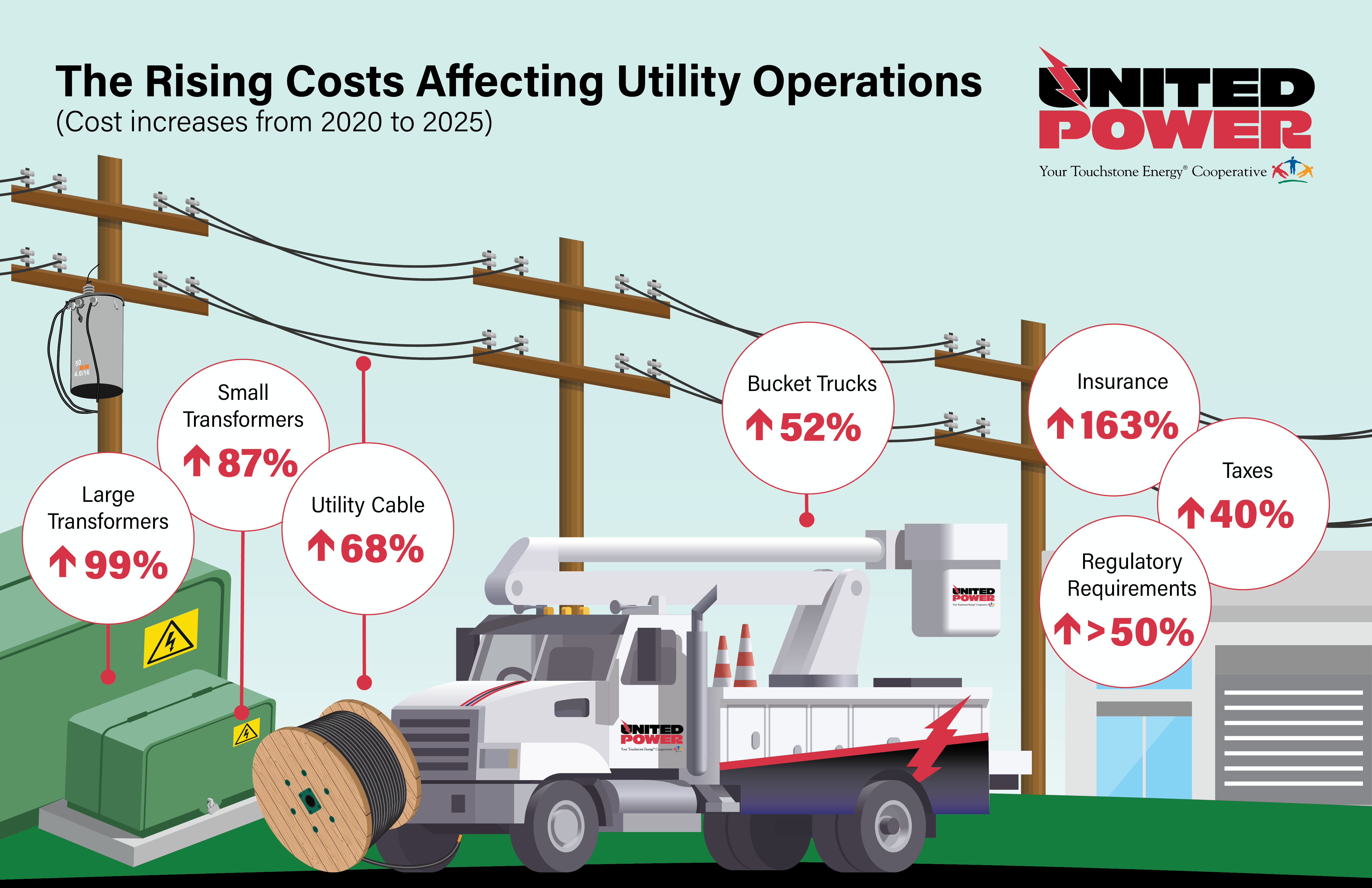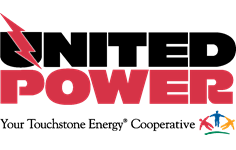Board Approves 2026 Rate Increase
Following a comprehensive study to determine the overall costs associated with serving each rate class, the United Power Board of Directors approved increases to the cooperative’s rates, including adjustments to both demand and fixed charges. These changes – which equate to an average monthly bill increase of $16-25, or 11.44%, for the majority of residential members – will be reflected for energy usage beginning Jan. 1, 2026.
In addition to the rate increase, the cooperative is shortening the current time of use window of 2-10 p.m. to 5-9 p.m. This will give members subscribed to any of the time-of-use rate options four additional hours of low-cost, off-peak power, affording them more flexibility in how and when they use their power. A comprehensive breakdown of rates and changes will appear in the December issue of the United Newsline, and additional information is available below.
United Power has worked hard to keep rate increases to a minimum the last five years. Since 2020, members have only had one year of rate increases, with members seeing no increase in 2025. However, the cost of nearly everything the cooperative needs to build and maintain its system continues to rise. Essential components like transformers and poles, the cost to outfit and support co-op crews with trucks, tools, and equipment, and the added pressures from growing transportation costs and tariffs brings an additional layer of uncertainty to the financial planning for operations. Expenses that nearly every home and business have seen increase in the past year, like insurance and property taxes, are also impacting the cooperative. Changing the mix of generation resources, as required by Colorado’s Clean Energy Plan, is another component of these growing costs.
Rate Increase Overview
United Power rates will increase, effective for usage beginning on Jan. 1, 2026. The average residential member will see increases in the fixed, demand, and energy charges.
This estimated average monthly increase is inclusive of an increase in the fixed charge of $3 per month ($19 to $22 per month), an increase in the demand charge of 55 cents per kW ($4 to $4.55 per kW), and an increase in the energy charge of 1.27 cents per kWh (10.57 cents to 11.84 cents per kW).
A comparison of the 2026 rates alongside current rates is available in the document linked below.
Cooperative Utility Rate Increases Around Colorado
Colorado Distribution Cooperatives
CORE Electric Cooperative, Sedalia
Delta-Montrose Electric Association, Montrose
Grand Valley Power, Grand Junction
Gunnison County Electric Association, Gunnison
Mountain View Electric Association, Limon
Poudre Valley REA, Windsor
Sangre De Cristo Electric Association, Buena Vista
San Luis Valley REC, Monte Vista
Colorado Generation & Transmission Cooperatives
Tri-State Generation & Transmission, Westminster
FAQs
This rate increase follows 18 months without an increase in rates. The cooperative’s last rate increase was effective June 1, 2024, and there were no rate increases for members in 2020, 2021, 2022, 2023, or 2025.
Virtually all utilities (electric, water, gas) are raising rates due to increasing costs. United Power’s 2026 increase will help to cover the growing costs that the cooperative continues to see in vehicles, fuel, insurance, taxes, and other everyday operating expenses. While inflation has impacted the co-op’s costs for these items and more, we are also challenged by supply chain issues. The timeline to order and deliver supplies and equipment continues to lengthen, and now many of these specialized items are subject to varying tariffs and delivery expenses that are often difficult to predict.
Here are a few examples of where the co-op has seen significant price increases over the last few years:
- The cost of the most common cables we use to build the electrical system has risen by 68% since 2020.
- Small bucket trucks, which represent a key way that we provide service, have risen in price by 52%.
- Transformers, which are essential for us to serve new members and ensure reliable service for current members, have seen steep increases. Smaller transformers have risen by 86%, while the largest transformers have doubled in cost.
- The same costs that have gone up for members have risen for the cooperative. The property taxes United Power pays for all facilities, including substations and offices, have increased. The cost of wildfire insurance has also ballooned due to some of the recent destructive fires in Colorado.
- As compared to similarly sized cooperatives across the country, we are proud to report that our operation remains among the leanest in the country – especially when looking at employee/labor expenses. However, employee costs have risen, including the cost of wages and benefits. United Power is committed to attracting and retaining the most talented and skilled employees, so we can provide members the most reliable service possible. The co-op carefully assesses how its wages compare to other utility providers to make sure that it can attract and retain the employees needed to both provide the service members expect and run the cooperative.
- Controllable costs represent only 14% of the cooperative’s total budget. Our largest costs are tied up in procuring wholesale power, the transmission needed to deliver power to the service area, and building and maintaining the delivery system in a high-growth region of the state.

The new rates go into effect for Jan. 1, 2026 usage.
Most members on the standard residential rate will see an average monthly increase of $16-25, with the amount depending on their actual power use and consumption. This estimated average monthly increase is inclusive of:
- An increase in the fixed charge of $3 per month ($19 to $22 per month)
- An increase in the demand charge of 55 cents per kW ($4 to $4.55 per kW)
- An increase in the energy charge of 1.27 cents per kWh (10.57 cents to 11.84 cents per kWh)
Members subscribed to a time-of-use rate will see increases in both on-peak and off-peak energy charges, but will enjoy fewer on-peak energy hours as the window shrinks by four hours from 2-10 p.m. to 5-9 p.m. This change will give members more off-peak hours to control household energy costs through changes in when power is used at home.
The “fixed charge” is a line item on the monthly billing statement that all members pay regardless of how much energy they use. The fixed charge is a standard amount and covers a portion of the costs for billing, collections, member services, metering, and other services that are required whether you use a lot of energy, or none at all.
In 2018, United Power uncoupled the blended cost of power and began charging separately for demand and energy. Demand correlates to a member’s impact on the electric system, while energy correlates to the amount of power they consume. Uncoupling these costs ensures that members are being charged more accurately for their impacts on the electric system and the costs they create. Demand is an important tool to assess costs to those who create the biggest draw on the United Power system.
Rate design is a complicated process with the goal of recouping costs in the most equitable manner possible. In assessing this latest rate increase, we used cost-of-service information to advise which components of the bill should increase and by how much. Demand was identified as one such area.
There are two ways a member can keep the cost of power low:
- Using less electricity
- Reducing demand
Replacing older bulbs with LED bulbs, turning off “vampire” electronics that run 24/7, upgrading insulation, caulking drafty windows, even replacing appliances with more energy efficient ones can help you use less electricity each month. To reduce demand, think about running only one appliance at a time. Shift things like doing laundry to bedtime so your washer is the only appliance running in the house.
United Power has several rates available for residential members. In fact, an analysis of 2024 aggregated usage data shows that approximately one-quarter of residential members could see a benefit if they opted to switch to the cooperative’s existing time of use rate. Contact member services to learn whether a time of use rate is right for you.
United Power is a huge proponent of rooftop solar systems and was honored by the Colorado Solar and Storage Association (COSSA) in 2022 for its track record of integrating solar resources onto the system. More than 10% of United Power members currently have solar, and we are proud of our success in interconnecting them.
As a cooperative, equity in our rates is very important. While solar systems are valuable on our system and generate power during the day, they do not generate during full peak use periods which extend into the evening. So, households with solar have a similar impact on demand when compared to non-solar households and, ultimately, the price United Power pays for wholesale power. The demand component makes certain all members are billed for their impact on the system in an impartial way.
United Power offers several solutions for members to manage their electric bills such as Budget Billing, Pay As You Go, and specialized rates that allow members, depending on their individual energy-usage profile, to achieve savings.
Additionally, there are both statewide services and local agencies throughout our territory where qualifying members can apply for assistance with their utility bills. The United Power Round Up Foundation even provides grants to several organizations to help fund these programs. You can find out more about available resources here.

